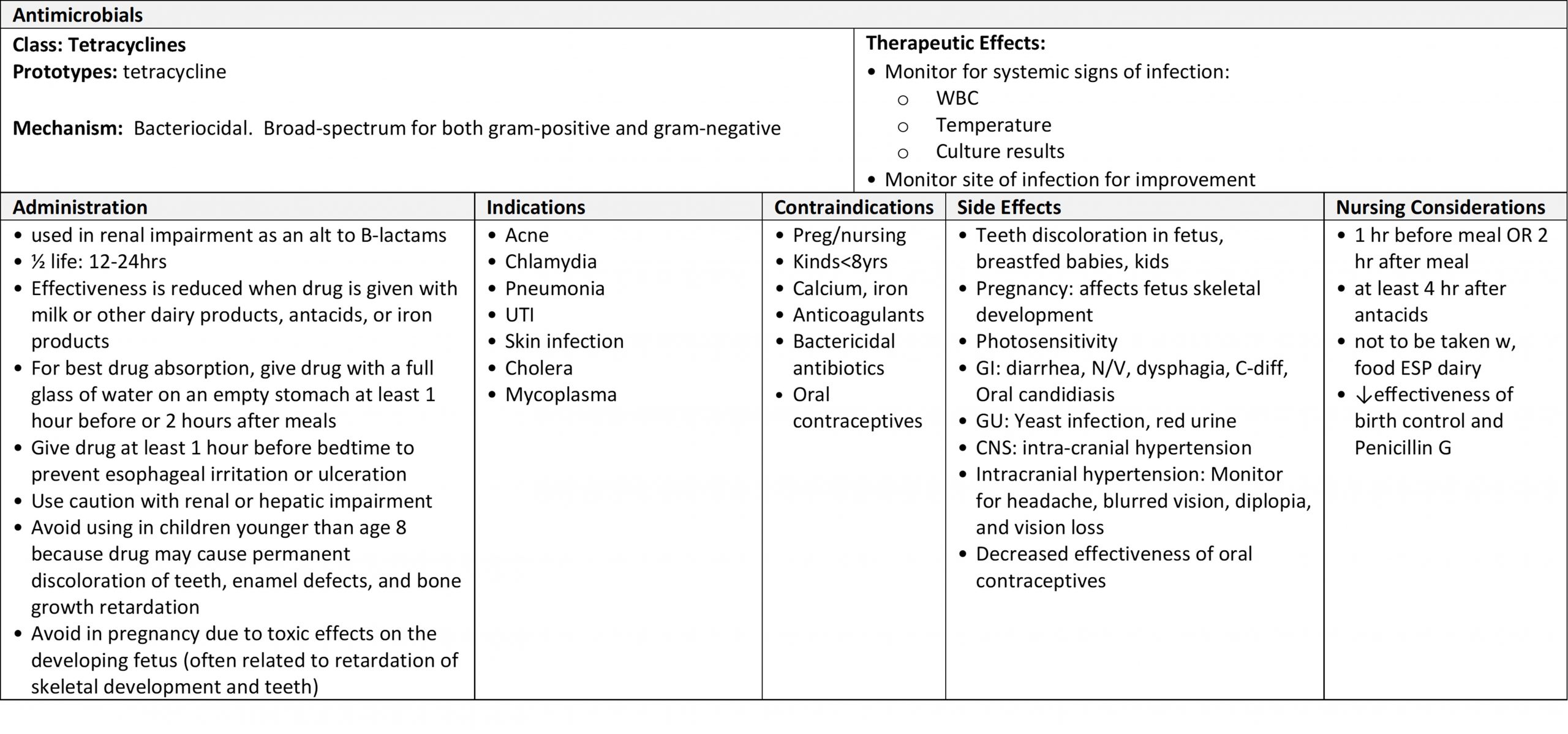Antimicrobials
3.14 Tetracyclines
Open Resources for Nursing (Open RN)
Tetracyclines are broad-spectrum antibiotics that are bacteriostatic, subsequently inhibiting bacterial growth.
Indications for Use: Tetracycline medications are useful for the treatment of many gram-positive and gram-negative infectious processes, yet are limited due to the significance of side effects experienced by many clients.
Mechanism of Action: Tetracyclines work by penetrating the bacterial cell wall and binding to the 30S ribosome, inhibiting the protein synthesis required to make the cellular wall.[1]
Nursing Considerations Across the Lifespan: Tetracyclines are contraindicated in pregnancy and for children ages 8 and under. Small amounts may be excreted in breast milk. For adults and older adults, dose adjustments need to be made for renal impairment.
Special Administration Considerations: Significant side effects of tetracycline drug therapy include photosensitivity, discolouration of developing teeth and enamel hypoplasia, and renal and liver impairment.[2]
Client Teaching & Education: Clients should be instructed to avoid direct sunlight exposure and wear sunscreen to prevent skin sensitivities. Additionally, it is important for clients to be educated regarding potential impaired absorption of tetracycline with the use of dairy products. Clients who are on oral contraceptives should be educated that tetracyclines may impede the effectiveness of the oral contraceptive and an alternative measure of birth control should be utilized while on the antibiotic. Female clients must be aware to immediately stop tetracycline if they become pregnant. Expired tetracycline should be immediately disposed of as it can become toxic.[3]
Now let’s take a closer look at the medication card for tetracycline in Table 3.13.[4][5]
Because information about medication is constantly changing, nurses should always consult evidence-based resources to review current recommendations before administering specific medication.
Table 3.13 Tetracycline Medication Card
Class: Tetracyclines (prototype: tetracycline)

Clinical Reasoning and Decision-Making Activity 3.13
Using the above information, consider the following clinical scenario question:
The nurse is providing medication teaching to a parent of a six-year-old child with strep throat in a clinic setting. Due to multiple drug allergies, tetracycline was prescribed by a doctor who is new to the clinic. What is the nurse’s best response and why?
Note: Answers to the activities can be found in the “Answer Key” sections at the end of the book.
Media Attributions
- Tetracyclines
- This work is a derivative of Microbiology by OpenStax licensed under CC BY 4.0. Access for free at https://openstax.org/books/microbiology/pages/1-introduction ↵
- This work is a derivative of Microbiology by OpenStax licensed under CC BY 4.0. Access for free at https://openstax.org/books/microbiology/pages/1-introduction ↵
- uCentral from Unbound Medicine. https://www.unboundmedicine.com/ucentral ↵
- Daily Med, https://dailymed.nlm.nih.gov/dailymed/index.cfm, used for hyperlinked medications in this module. Retrieved June 27, 2019 ↵
- UpToDate (2021). Tetracycline. https://www.uptodate.com/contents/search ↵

